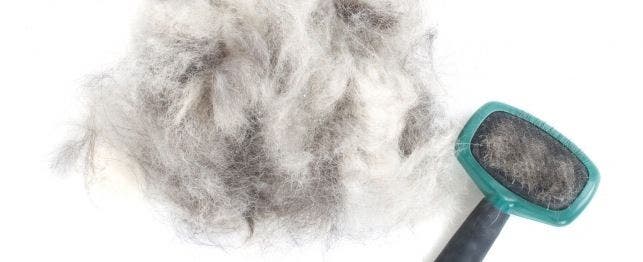
Shedding in Dogs
If you read or hear about how some breeds of dogs don’t shed, you can discount it. Every dog sheds – some more than others – but they all shed.
So why then do some dogs appear not to shed while others shed so much you could weave a thick blanket out of the discarded fur? The answer lies in the growth rate of the hair, which is based on genetics, nutrition and environment.
Shedding is the process by which old hair naturally falls out and new hair begins to grow in its place. The new hair does not “push out” the old hair. Since hair growth and loss is a continual cycle, there is no true starting point.
When dogs run free in the wild, they brush up against bushes, trees and other flora. This action removes old hair naturally. Our house pets need brushing to accomplish this same goal and to prevent large amounts of hair from accumulating in the coat. But brushing is also good for your dog. It not only decreases the amount of hair on your clothes and furniture; it also stimulates the blood supply to the skin. And brushing your dog’s hair helps to prevent skin parasites, such as mites, fleas and ticks, from infesting your pet and your home and keeps unsightly and sometimes painful mats from forming.
Once the individual old hair has been removed, new hair can form. The growth of hair occurs in three cycles:
- Anagen. This is the initial hair-growing phase, the period of active production by the hair follicle.
- Catagen. After the hair has grown to a specific length, determined by genetics, the hair enters this temporary transitional state.
- Telogen. After a brief time, the hair then enters the final resting phase or non-growing state.
Exactly when the hair falls from the follicle and sheds depends on environment, heredity and nutrition. For “non-shedding” dogs, the hair growth is much slower and few hairs are shed at a time, giving the false impression that the dog does not shed.
At any point, approximately 90 percent of a dog’s hair is in the growth stage. The remaining hair is in either the resting or transitional phase. The growing phase occurs in patterns and is not synchronized all over the body.
Shedding in dogs is influenced by the amount of time spent in the sunlight and by temperature fluctuations. Outdoor dogs usually shed their thick undercoat in the spring to prepare for warmer weather. Indoor dogs shed all year long but in smaller amounts, since they are exposed to a more constant temperature and consistent light source. A dog’s shedding cycle may also change as the pet ages or becomes ill.
Some female dogs shed more hair than usual after they have been in heat. This usually occurs around 3 to 4 years of age, if at all. Some breeders refer to this as “blowing their coat.”
Puppies‘ coats are usually fuzzy with short, downy hair. In some breeds this hair may not change to the adult coat until the age of 5 months. The best time to begin grooming is when your pet is still a puppy. By spending a few minutes every day gently brushing your puppy, you are creating a close, trusting bond. Eventually, your dog may look forward to this time every day.
Adequate grooming, proper diet and exercise all contribute to a shiny, healthy-looking coat and a happy pet. If your dog appears to be losing a large amount of hair and/or if the coat is dull and dry, see your veterinarian.
Grooming Tips
Brush short-coated dogs two to three times per week whether they have smooth or rough hair. You can use a hound glove (a grooming glove with wire bristles in the palm) with medium-soft bristles. Gently brush in the direction of hair growth (with the grain).
Medium-coated dogs like golden retrievers require a slightly firmer bristle brush. Be sure to brush the feathering (longer hair) on the chest and legs, too. Again brush with the grain of the hair.
Long-coated dogs, such as Yorkshire terriers and Afghan hounds, require a soft, long-bristle brush and wide-tooth comb and should be brushed daily. Grasp a handful of hair and gently brush from the skin outward, paying special attention to mats. Severe mats can only be removed by careful shaving, which should only be done by your veterinarian or a professional groomer. Combing afterward can help smooth the coat.
Dogs with double coats, such as Alaskan malamutes and Pomeranians, require a stiff long-bristle or wire brush. These breeds have a thicker undercoat that can get trapped in the outer coat during shedding. Brush with the grain of the hair at least two to three times weekly. Daily brushing is recommended during the shedding period.
Carder or slicker brushes are also useful. These consist of a small, flat board with multiple, fine wire teeth on one side and a short handle. They are especially useful with mats. You may need to experiment with several types of brushes before you find the one that is best for your dog.
Brushing is only one part of a thorough grooming regimen, and if done on a regular basis, only about 10 minutes a day are needed. To learn more about grooming, consult your veterinarian or a professional groomer.